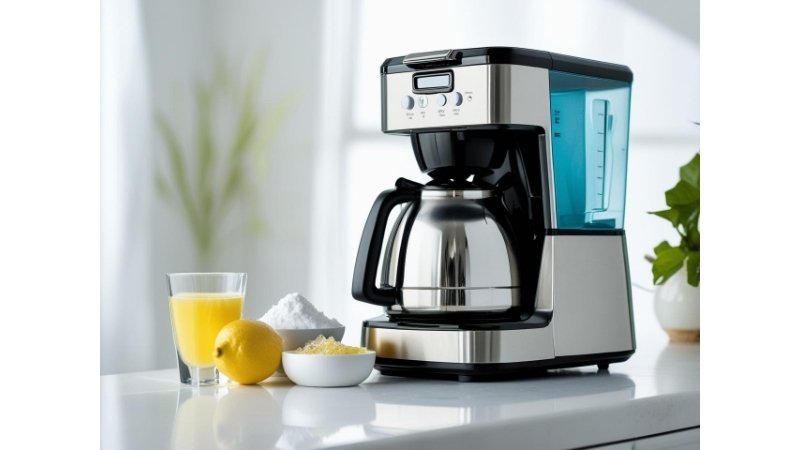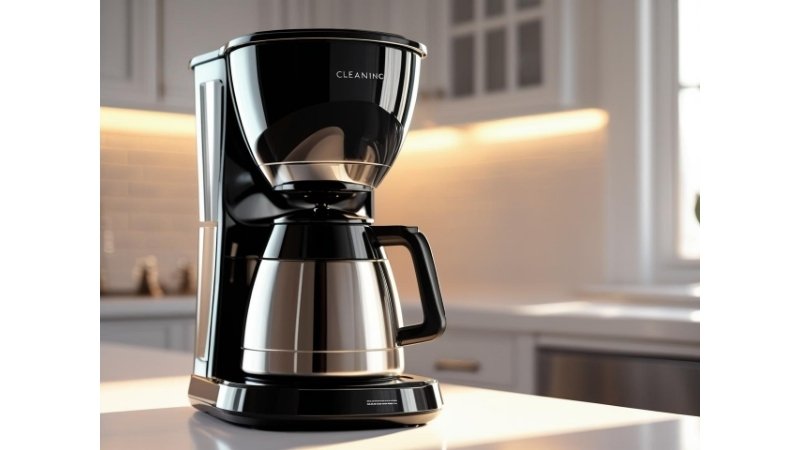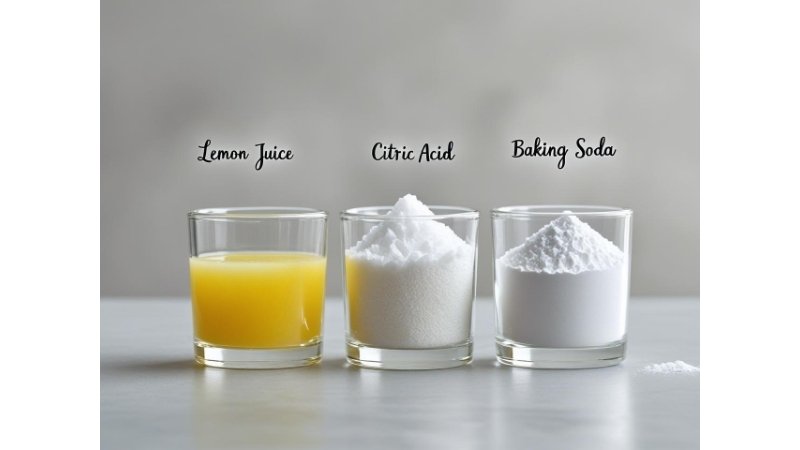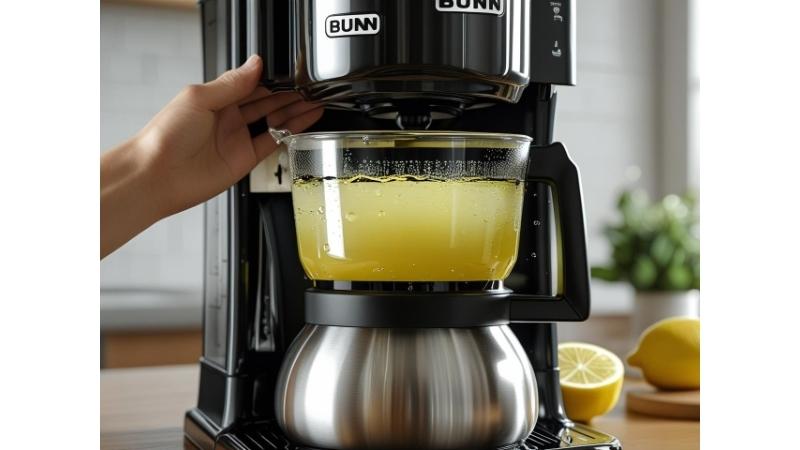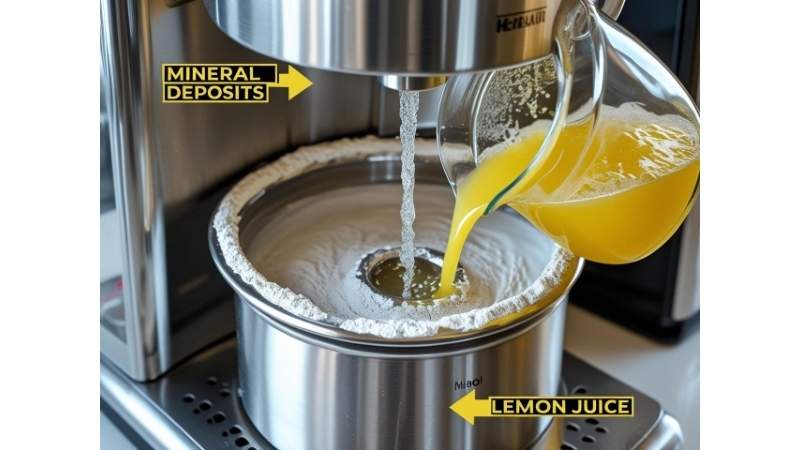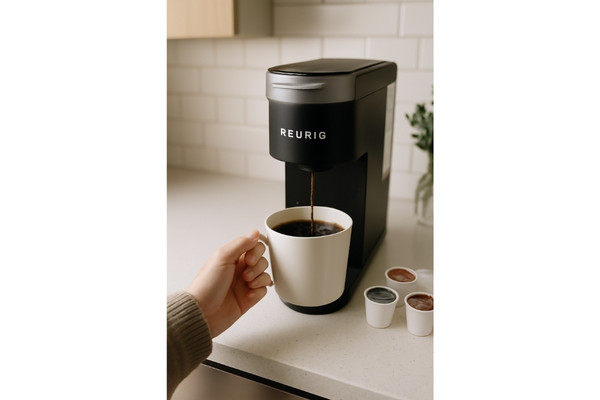Cleaning your coffee maker is key to a fresh cup every morning. But what if you don’t want to use vinegar? Many people avoid it because of the strong smell, taste, or irritation. If you’re looking for a better option, you’re in the right place. In this guide, I’ll show you how to clean a coffee maker without vinegar. These simple, natural methods will keep your machine in great shape and make your coffee taste fresh. Let’s get started and clean your coffee maker without vinegar!
Why Choose Vinegar Alternatives for Cleaning Your Coffee Maker?
Vinegar: The Traditional Choice vs. Natural Alternatives
Vinegar is often the first thing people reach for when cleaning their coffee maker. It’s cheap and works well to remove mineral buildup. But, if you’ve ever used it, you know it comes with a downside. The smell can be too strong, and sometimes it leaves a taste that ruins your next cup of coffee. Plus, if you’re sensitive to acids, vinegar might even cause some irritation. So, while vinegar is effective, it’s not always the best choice for everyone.
This is where natural alternatives come in. Simple items like baking soda, lemon juice, and citric acid can clean your coffee maker just as well, without the strong odor or aftertaste. These alternatives don’t just clean—they help keep your coffee tasting fresh and your machine in great shape for a longer time. Many people are starting to turn to these gentle, natural cleaners instead. They do the job without any of the downsides of vinegar.
“learn How to Clean a Coffee Maker Without Vinegar – step by step”
Eco-friendly and Non-toxic Options
People are more conscious than ever about using natural and eco-friendly cleaning solutions. Vinegar may be natural, but it can be harsh and has its own set of problems. On the other hand, natural alternatives like lemon juice and citric acid are free of harsh chemicals. They’re safer for both you and your coffee maker. Plus, these options are easier on the environment. By choosing natural cleaners, you’re cutting down on the chemicals in your home, making it a healthier place for everyone.
Using non-vinegar methods is not only better for the environment but also helps your coffee maker last longer. Harsh chemicals can wear down your machine over time, which leads to problems later on. Natural cleaners are much gentler, keeping your coffee maker in great shape. They clean without causing unnecessary wear and tear.Your coffee maker will appreciate it!
Choosing a vinegar-free cleaner is a great way to enjoy fresh coffee and a clean machine. It’s also a simple way to make your home a bit more eco-friendly and healthier. Now, let’s dive into some great vinegar-free options you can try out to keep your coffee maker running smoothly!
Top Vinegar-Free Methods for Cleaning a Coffee Maker
Cleaning your coffee maker without vinegar is easy. There are many effective methods to do it. Here are the top vinegar-free ways to ensure your coffee maker stays spotless and your coffee remains delicious!
1. Baking Soda: A Simple, Effective Alternative
Baking soda is great for cleaning! It’s mild but works wonders. It removes stains and odors without being harsh on your coffee maker. I’ve used it many times and love how easy it is to use. Plus, it leaves your coffee maker clean without the strong smell of vinegar.
How to clean your coffee maker with baking soda:
- Pour warm water into the water reservoir, filling it halfway.
- Take one tablespoon of baking soda and stir it into the water.
- Run a brew cycle. The baking soda will clean the inside of the machine.
- After the cycle, throw the water away. Run another cycle with just water to rinse everything out.
Tip for removing coffee stains and odors: You can use baking soda to clean the coffee pot too. Just mix it with a little water to form a paste. Use the paste to scrub away stains and smells.
2. Lemon Juice: Nature’s Descaler
Lemon juice is a great natural cleanser that helps break down mineral buildup. It works well to keep your coffee maker running smoothly and smells fresh. The best part? It’s gentle but effective.
How to clean your coffee maker with lemon juice:
- Mix 1 part lemon juice and 1 part water (about 1 cup each).
- Pour the mixture into the water reservoir.
- Run a brew cycle, just like you would with vinegar.
- Once the cycle is done, run another cycle with just water to rinse the machine.
Bonus: Lemon juice can also help keep your coffee tasting fresh by stopping mineral buildup. It’s a win-win!
3. Citric Acid: The Eco-Friendly Descaling Solution
Citric acid is another great natural cleaner. It’s derived from citrus fruits and is gentle on the environment. It works well to break down tough mineral deposits. Citric acid is a stronger option if your machine has heavy buildup.
How to use citric acid:
- Put 1 to 2 tablespoons of citric acid in around 4 cups of water.
- Pour the solution into your coffee maker’s reservoir.
- Start a brew cycle and allow the solution to sit for 10 minutes.
- Run a few cycles with just water to rinse the machine.
How it compares to vinegar: Citric acid is similar to vinegar but works better at removing minerals. It’s less likely to leave an aftertaste, making it a good choice for regular cleaning.
4. DIY Coffee Maker Cleaner: Natural Ingredients You Already Have
If you prefer to make your own cleaner, you can easily mix up a natural cleaning solution using ingredients you probably already have. It’s cost-effective and eco-friendly.
DIY Coffee Maker Cleaner Recipe:
- 1 cup of water
- 1 cup of lemon juice (or citric acid if you prefer)
- 1 tablespoon of baking soda
How to use the solution:
- Mix all the ingredients in your coffee maker’s water reservoir.
- Run a brew cycle, letting the solution clean the inside.
- Let it sit for about 10 minutes, then run a cycle with clean water to rinse.
This simple DIY cleaner is a great way to keep your coffee maker in top shape without any harsh chemicals.
How to Clean a Bunn Coffee Maker Without Vinegar
Bunn coffee makers brew quickly and make great coffee. But, they need regular cleaning to stay in good shape. If you’re wondering how to clean a Bunn coffee maker without vinegar, you’re in the right place. I’ve cleaned my Bunn with natural methods for years, and I can tell you it works just as well. Plus, there’s no vinegar smell or aftertaste to deal with!
Bunn coffee makers are a bit different. They brew quickly and constantly use hot water. This can lead to mineral buildup. But don’t worry—natural solutions like lemon juice or citric acid are perfect for the job. You don’t need any harsh chemicals to clean your machine. Let’s dive into some simple methods!
Cleaning with Lemon Juice
Lemon juice is my favorite cleaner for Bunn coffee makers. It’s a natural, gentle way to remove mineral buildup. To clean your Bunn, mix one part lemon juice with one part water—about one cup of each. Pour this mixture into the water reservoir. Then, run a brew cycle. Once done, run a few more cycles with just water to rinse it all out. The bright, fresh scent of lemon adds a pleasant touch to the cleaning process!
Citric Acid: A Stronger Option
If your Bunn has a lot of mineral buildup, citric acid is a great choice. It’s stronger than lemon juice and works well on stubborn deposits. To use it, mix 1-2 tablespoons of citric acid in about 4 cups of water. Pour this solution into the coffee maker. Run a brew cycle, and let it sit for 10 minutes. After that, rinse with clean water. Citric acid is similar to vinegar, but it won’t leave an aftertaste.
A Personal Tip for Cleaning the Pot
I also clean the coffee pot with baking soda. It’s great for getting rid of coffee stains. Just sprinkle a little baking soda into the pot and add warm water. Let it sit for a while. Then, scrub with a soft sponge. It will keep your pot looking clean and fresh.
Cleaning your Bunn coffee maker with natural products is easy. It keeps your machine running smoothly and your coffee tasting great. Trust me, your coffee maker will thank you for the care!
“Learn How to clean Jura Cleaning Guide – step by step”
How to Clean a Drip Coffee Maker Without Vinegar
We all know the feeling—your drip coffee maker is getting a little dirty, and it’s time for a clean. But maybe you’re not a fan of vinegar. The strong smell or aftertaste might not be your thing. No problem! You can clean your drip coffee maker without vinegar and still keep it fresh. Let me show you how. It’s easy, and your coffee will taste better too!
“If you’re using a Braun coffee maker, here’s a dedicated cleaning guide for Braun models.”
The Process for Cleaning a Drip Coffee Maker Without Vinegar
When I first tried cleaning my coffee maker without vinegar, I thought it would be hard. But it’s actually simple. Lemon juice, baking soda, and citric acid work just as well, if not better. They break down mineral buildup and keep your coffee tasting fresh. They’re gentle on your machine but tough on dirt.
Here’s the routine I follow:
- Lemon Juice: Mix equal amounts of lemon juice and water. Pour it into the reservoir. Run a brew cycle. The acid in lemon juice will help dissolve mineral buildup. After the cycle, run a couple of water-only cycles to rinse the machine. It keeps your coffee fresh and the machine clean.
- Baking Soda: Baking soda works great too. Just add one tablespoon to the water reservoir. Run a brew cycle, then rinse with clean water. Baking soda helps remove odors and stains. You won’t have that strong vinegar smell anymore.
- smell.
- Citric Acid: If your coffee maker has heavy mineral buildup, citric acid is a great choice. Mix 1-2 tablespoons of citric acid in 4 cups of water. Run a brew cycle and let it sit for a few minutes. Afterward, rinse with clean water. Citric acid works well on stubborn deposits and doesn’t leave an aftertaste.
Different Methods for Cleaning and Descaling Drip Coffee Makers
Each method works a little differently. Lemon juice is great for a quick clean. Citric acid is perfect for tough mineral deposits. Baking soda is best for routine cleaning. I use lemon juice most often. It’s fast and leaves the coffee maker smelling fresh.
Switching between these methods will keep your coffee maker in great shape. If you brew coffee daily, try cleaning it once a week. If you brew less often, once a month should be enough.
Tips for Keeping Your Drip Coffee Maker in Top Condition Without Harsh Chemicals
Cleaning your coffee maker doesn’t have to be a hassle. You don’t need any harsh chemicals to keep it running smoothly. Here are a few tips I use to maintain mine:
- Clean Regularly: I clean my coffee maker once a month. If I use it a lot, I clean it more often to avoid mineral buildup and stains.
- Rinse After Each Brew: After each brew, I rinse the coffee maker with water. This helps remove any oils or coffee grounds left behind. It makes the next cup taste fresher.
- Clean the Carafe: Don’t forget the coffee pot! Baking soda works great to clean stains inside. Just mix it with water and scrub. It keeps the pot clean and fresh.
A Quick Recap
Cleaning your drip coffee maker without vinegar is easy and effective. Whether you use lemon juice, baking soda, or citric acid, you can clean your coffee maker naturally. These methods work well, are better for your machine, and are kinder to the environment. With a little regular cleaning, your coffee maker will run smoothly, and your coffee will taste great. No harsh chemicals needed!
Happy brewing!
Best Practices for Maintaining a Coffee Maker Without Vinegar
Keeping your coffee maker clean doesn’t have to be hard or require harsh chemicals. Over the years, I’ve found a few easy habits that make a big difference. These tips help keep your machine in good shape, so every cup of coffee tastes great. Let me share how I maintain mine, and how you can too.
Daily Maintenance Tips:
After each cup, a little cleaning goes a long way. Here’s what I do every day to keep my coffee maker fresh.
- Rinse After Each Brew: I always rinse my coffee maker after every brew. This step is simple but so important. It helps get rid of coffee oils and grounds that can make your machine smell or taste stale. A quick rinse keeps it clean and ready for the next use.
- Clean the Coffee Pot: Coffee stains can build up fast, right? To avoid that, I quickly clean my coffee pot after each brew. A little warm water and a dash of baking soda does the trick. I just let it soak, scrub it lightly, and it’s spotless.
- Dry the Parts: Once everything is cleaned, I make sure to dry it properly. A quick wipe down of the carafe and lid helps avoid water spots and keeps mold or mildew from growing. It takes a few seconds, but it makes a big difference in the long run.
Weekly and Monthly Maintenance:
Regular maintenance helps your coffee maker last longer. These easy routines will help your coffee maker run like new.
- Descale Regularly: Descaling is important for keeping your coffee maker in top shape. Every week or so, I run a cycle with lemon juice or citric acid. This helps break down any mineral buildup from hard water. I mix 1 part lemon juice (or citric acid) with 1 part water, pour it in, and run a brew cycle. After that, I run a couple of cycles with clean water to rinse everything out. This prevents buildup and keeps the coffee tasting fresh.
- Check for Mineral Buildup:If you use hard water, minerals can collect in your coffee maker over time. I keep an eye out for any signs of buildup and clean it as soon as I notice it. The quicker you clean it, the easier it is to remove. If you let it sit too long, it becomes harder to get rid of.
- Clean the Carafe Thoroughly: Once a week, I deep clean the carafe. I sprinkle a little baking soda inside and scrub away any stains or oils. I also clean the lid and other parts that touch the coffee. This step helps keep everything looking nice and working well.
How to Prevent Coffee Stains and Mineral Deposits Without Vinegar:
A clean coffee maker starts with good habits. By following the daily and weekly routines, you can prevent stains and mineral deposits before they even start.
- Use Filtered Water: One easy way I reduce mineral buildup is by using filtered water. It keeps the machine cleaner and means I don’t need to descale as often. Plus, it makes my coffee taste better!
- Avoid Overfilling: I’ve found that overfilling the water reservoir can lead to spills and extra mess. I always stick to the recommended amount of water for each brew. This simple step helps keep my machine clean and avoids extra residue.
Recap
Taking care of your coffee maker without vinegar is simple and effective. Rinse it daily, descale weekly, and check for mineral buildup. This will keep your machine in good shape. Regular cleaning helps it run well and keeps your coffee tasting fresh. Plus, it will help your coffee maker last longer. No vinegar needed—just follow these easy steps and enjoy your coffee more!
How to Remove Mineral Buildup in Your Coffee Maker Without Vinegar
If you’ve noticed your coffee doesn’t taste as good or your coffee maker is brewing slowly, it could be due to mineral buildup. This happens when minerals like calcium and magnesium from your water settle inside your machine. It’s easy to fix this problem without vinegar. Here’s how to clean your coffee maker naturally and keep it running smoothly.
“Read what cleaning experts at Good Housekeeping recommend as vinegar-free methods.”
Why Mineral Buildup Matters
Mineral buildup can slow down your coffee maker and affect the taste. When minerals build up, they block the system. This can make your coffee taste weak or stale. It can also shorten the life of your coffee maker. That’s why regular cleaning is important.
Step-by-Step Instructions for Cleaning
Removing mineral buildup is easy with two natural ingredients: citric acid or lemon juice. Here’s how I do it:
- Use Citric Acid or Lemon Juice
- For citric acid, mix 1-2 tablespoons in 4 cups of water.
- For lemon juice, mix equal parts of lemon juice and water (about 1 cup each).
- Add the Solution to Your Coffee Maker
Pour the mixture into your coffee maker’s water reservoir. Let it fill up completely. - Run a Brew Cycle
Start a brew cycle. The solution will clean out the mineral deposits inside your machine. Let it sit for about 10 minutes if needed. - Rinse with Water
After the cycle finishes, run 2-3 more cycles with just water to rinse the machine.
How to Know When to Clean Your Coffee Maker
You’ll know it’s time to clean your coffee maker if:
- It brews slowly. Mineral buildup can slow down the water flow.
- The coffee tastes bad. If your coffee tastes off, minerals might be affecting the flavor.
- You see white spots. These are mineral deposits on your machine.
If you notice any of these signs, it’s time to clean your coffee maker. A quick clean will help keep it running smoothly.
Recap
Mineral buildup can affect both your coffee and your coffee maker. But cleaning it doesn’t have to be hard. Citric acid or lemon juice are easy, natural ways to remove buildup. Regular cleaning will make your coffee taste better and help your machine last longer. So, grab some citric acid or lemon juice, and give your coffee maker the clean it deserves!
“Also, don’t forget to clean your K-Cups too—here’s how.”
Conclusion
Cleaning your coffee maker without vinegar is quick and effective. You can try using ingredients like baking soda, lemon juice, citric acid, or even create your own homemade cleaner. These natural options are not only better for you, but also for the environment.
From my personal experience, these methods really work. I love using lemon juice—it cleans thoroughly and leaves a refreshing scent. These easy steps help extend the life of your coffee maker and ensure your coffee tastes as fresh as ever.
Take a few minutes each month to clean your coffee maker. It’s an easy habit that keeps everything running smoothly. Your coffee maker—and your morning brew—will thank you!
Happy brewing!
FAQ
How can I clean my coffee maker without vinegar or baking soda?
Cleaning your coffee maker without vinegar or baking soda is a breeze! I use lemon juice or citric acid as natural cleaners. Simply mix lemon juice with water or citric acid with water, pour it into your coffee maker, and run a brew cycle. Then, rinse the machine with clean water. It’s fast, easy, and effective—no vinegar smell to worry about!
Can lemon juice replace vinegar for cleaning my coffee maker?
Yes, lemon juice is a perfect alternative to vinegar. It helps break down buildup and leaves a refreshing smell. I combine lemon juice with water in equal amounts. Then, I run the mixture through the coffee maker and rinse it out afterward. It’s just as effective as vinegar, but much more pleasant!
How often should I clean my coffee maker without vinegar?
If you use your coffee maker every day, aim to clean it once a month. For frequent use, clean it weekly. If your coffee brews slowly or the coffee starts to taste off, it’s time for a cleaning. Regular cleaning helps your machine stay in good condition and ensures your coffee tastes fresh.
Can I use citric acid regularly for cleaning my coffee maker?
Yes, citric acid is great for regular cleaning! I use it all the time to keep my coffee maker in great shape. Just mix 1-2 tablespoons with water, run it through the machine, and rinse it with clean water. It’s an easy and natural way to maintain your coffee maker.
What’s the best method to clean a Bunn coffee maker without vinegar?
For a Bunn coffee maker, I recommend using lemon juice or citric acid. Mix one part lemon juice with one part water or use citric acid in water. Run it through your coffee maker, and be sure to rinse with clean water afterward. This method works well for removing buildup and keeping your Bunn clean without vinegar.
Let me know if you have any more questions! I’m happy to help.
